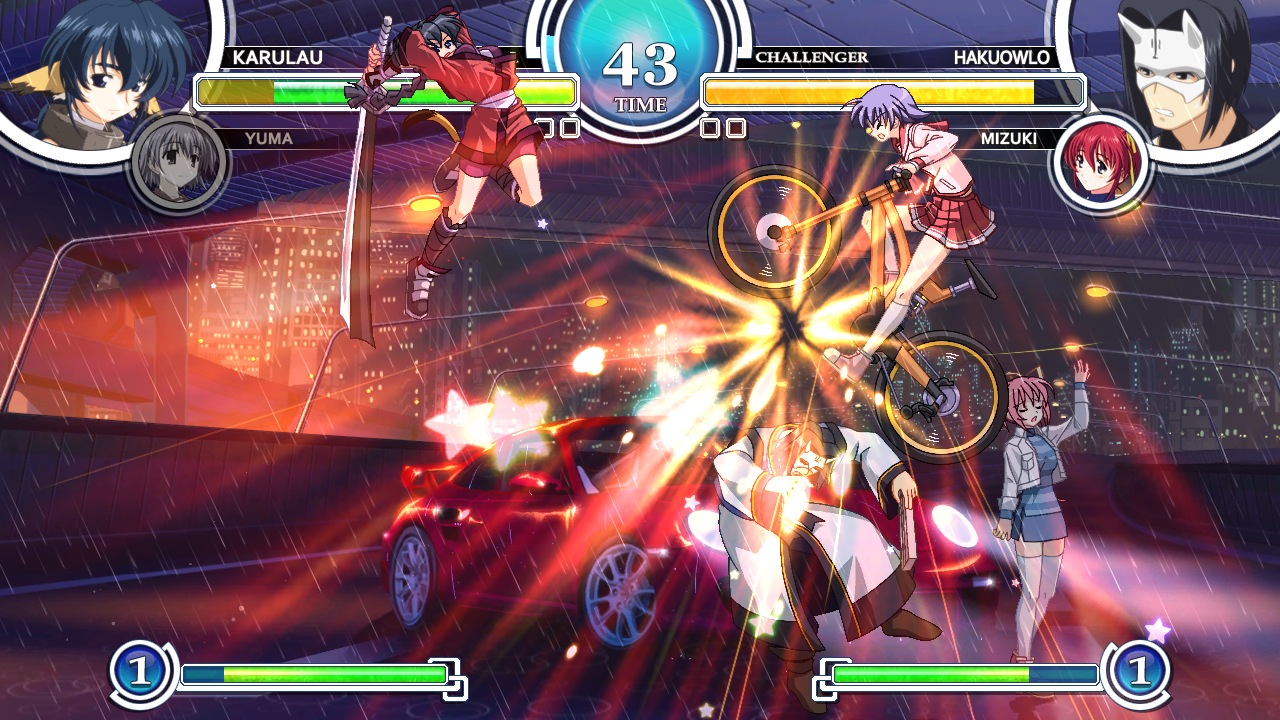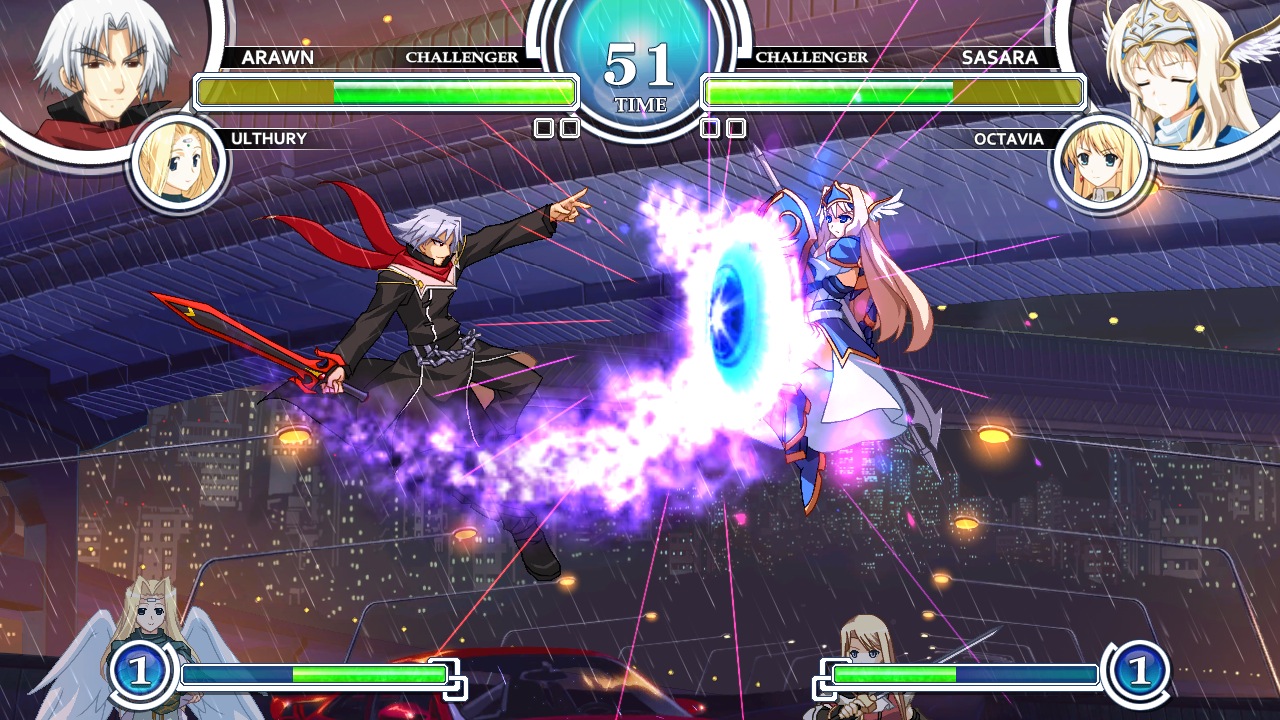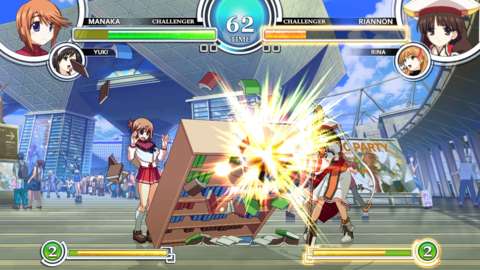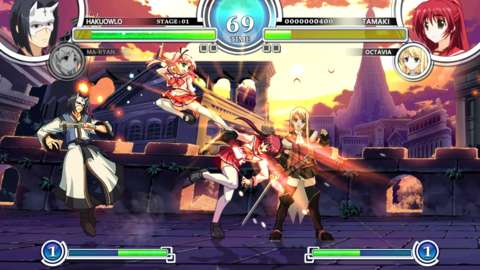Aquapazza is a tough sell to the current fighting game crowd. It's a crossover game featuring only characters from the Japanese visual novel company Aquaplus, being released into a market where the fighting game crowd has a healthy amount of other, more established one-on-one fighters to pick from. The game's low price makes it more appealing to potential buyers, however, and for those willing to dive on in, however, there's a charming fighter beneath the unfamiliar waters.
The cast from Aquapazza is culled from a variety of Aquaplus' visual novel offerings, including characters from To Heart, Utawarerumono, White Album, Comic Party, Tears to Tiara, and other titles. If you recognize the names of none of these games, that's perfectly understandable--none of them have been officially made available to play in English. To all but the most seasoned otaku, Aquapazza's mostly female cast looks like a weird conglomeration of generic fantasy tropes, schoolgirls, and animal-eared folks, very few of which feature the sort of flashy, attractive designs fighting game fans adore. The merely adequate character animation and art don't do them any favors, either, and the lack of context for the source material hurts Aquapazza on more than just an initial-impression level. The story mode, which pits these characters from disparate games against each other, makes very little sense if you don't already understand the characters and their relationships with one another.

Where a fighting game truly lives or dies, however, is in the strength of its gameplay systems. Compared to a game like BlazBlue, Aquapazza's systems are simple, making it easier for players of all stripes to jump into, but it still has plenty of competitive meat on its bones.
You choose two characters: a main character and an assist character, though oddly, the assist character can never be summoned into the fight directly, nor can he or she take damage. Hits can be chained from light to heavy, and you can perform slow-moving damaging strikes that knock opponents down. Special moves are performed with the usual array of quarter-circle-forward motions and variants, while stronger super moves require more complex inputs and use either one or three stocks from a character's power gauge. Universal defensive options include an impact guard performed by pressing back as soon as your opponent's strike is about to hit (which negates chip damage and provides other benefits), a quick recovery by holding up when knocked down, and an assist-character counterattack which uses one power gauge stock. All characters have the same amount of life, and generally the same type of attack does similar damage with each character across the board. It’s not tough to get the feel of how combos into special moves work, and you can start doing some basic strings from the get-go.
The game works to encourage you to go on the offensive by bestowing conditions of "emotion high" and "emotion low" on the fighters.
Where Aquapazza's gameplay gets interesting is in the unique capabilities of each character and assist, as well as in its "emotion" element. Characters move in distinct ways that factor heavily into how they are played. Double-tapping with some characters gets you a short hop forward, while others dash forward and can execute special while-running attacks. A few characters have high and double jumps; only one (Sasara) has an air dash. Still others, like perpetually book-encumbered Manaka, have unique traits in their basic walks and jumps that give them a distinct method of handling. The diversity makes simply learning the way each character moves around the screen a joy.


Picking an assist is also vital to your gameplay. Assists offer up to two variant attacks, each of which has distinct properties. Some attacks deal direct damage as the assist jumps into the arena, some have a delay before they hit (allowing for combo setups), some are projectiles, and some are more effective as defensive punishing attacks. Other skills don't deal direct damage to the foe but work to make it easier for you to get in and do damage, such as slowing down time, holding a foe defenseless in place, giving your basic and special attacks extra hits, or boosting your basic attacks with extra damage. There's a lot of potential strategy and synergy in creating a player/assist team, and the degree to which assists affect the gameplay makes Aquapazza stand out. Some assists are better suited to certain characters than others (using a combo-focused assist isn’t a good idea with a grappler character like Tamaki), so picking the right assist--and knowing when to use it--can give you a strong edge. They can also be extremely useful in extending combos, leading to clever strings of damage that leave foes hurting and you with a wicked smile on your face.
Another particularly interesting conceit is the emotion system. The game works to encourage you to go on the offensive by bestowing conditions of "emotion high" and "emotion low" on the fighters. When you're attacking and racking up combos and super hits, your emotions will rise, eventually putting you in a state of "emotion high," where your damage is augmented, your attacks cause more blockstun, and your super moves get additional animations and an increase in potency. Emotion low, meanwhile, is triggered when you block, backdash, or otherwise avoid aggressively engaging the opponent for long stretches of time, and greatly increases the damage you take, as well as your odds of getting guardbroken. Certain defensive skills, like impact guard and assist counterattacks, can affect your emotion positively, making them vital to learn and use. This aspect of the game keeps battles moving quickly and encourages you to not only be active, but to learn and use a full range of skills. It's an interesting game of seesaw: You won’t want to turtle and wait for openings, but instead to go all-out and find ways to force opponents into a state in which their character’s emotions will degrade.

The package features some well-thought-out extras. Training mode comes with a robust set of features, including recording and playback and detailed input and damage info, but also allows you to quickly swap characters and assists without needing to back all the way into the selection screen. Changing control setups is highly convenient and still surprisingly underused among fighting games in general. Online play is solid, with a wealth of collectable titles to assign to your profile and match recording and replay features. The only thing lacking is a comprehensive tutorial for the game's mechanics; training mode features a few optional combo demonstrations, but learning the game's ins and outs requires some trial and error.
Aquapazza is a welcome addition to this year's fighting game releases. It's not the most immediately appealing of games, due to its uninteresting character lineup, but digging beneath the surface reveals a solid fighter that's fun to learn and play. It's unlikely to replace some of the bigger, more technical, and prettier fighters as your go-to versus game of choice, but it's a pleasant, enjoyable diversion when you need some airy, unfettered fun.



